Artists in the Garden: Rich Gray
Rich Gray is a self taught origami and paper artist. He also sells his unique and colorful jewelry in local stores and teaches origami here at Norfolk Botanical Garden. Rich’s studio is quiet and peaceful. Organized and clean. A menagerie of mobiles hang from the ceiling – butterflies, birds, fish, ornaments, even a rather large bat peering at me.
Rich jokes “I make the most of my track lighting.” Indeed. 
His wife Pam’s studio is nearby – they can wave to each other from their individual working spaces. Their home and yard are adorned with things of beauty, contemporary Japanese woodblock prints, colorful ceramics, and even a fragrant paper bush! When we go out back to take a peek into her studio, Pam is listening to Fleetwood Mac’s “Rhiannon.” She tells me that she sells her wares at Texture of Ghent. She greets me with smiling eyes in her artfully splattered apron. Rich and I leave Pam to her work and head back up to his studio to settle in for a socially distanced conversation.
CB: Why paper?
RG: I think everybody has a medium that appeals to them, ya know since my wife’s a potter, I know more potters than people in paper. And potters usually say there they were and as part of their art program they had to do clay and they touched clay and they just knew that was their material. With me it was paper. It’s an incredibly just versatile material. I’ve got stuff in here that’s so gossamer it would just drift off and yet, once upon a time they actually made armor out of paper. And they actually tested it! You can do so much with it. It’s light, it’s strong, it’s got so many different textures. I’m not somebody who does a lot of coloring the paper myself. I can just get paper in so many different colors and I just like the way it feels when I handle it. And for me it’s clean. Clay, I don’t really like to get my hands dirty. Sorry, I’m a house cat.
CB:How did you get started in paper arts?
RG: Well, my first exposure was when I was a kid in elementary school and I saw a program on public television. It was a Japanese gentleman actually doing origami, well you gotta remember this was back around circa 1960 you didn’t have tevo … it fascinated me. It was like wow he took this plain piece of paper and turned into a bird and it kind of stuck in the back of my brain and then y’know typically in school you learn to do things like the fortune teller and things like that. . . the really simple stuff and in the 60s, is when you first started being able to find books on origami in the bookstores. And so my parents who always encouraged me – I always loved to make stuff with my hands and my dad was a handyman, he taught industrial art – so I was always used to working with materials and so they got me the books and I just taught myself.
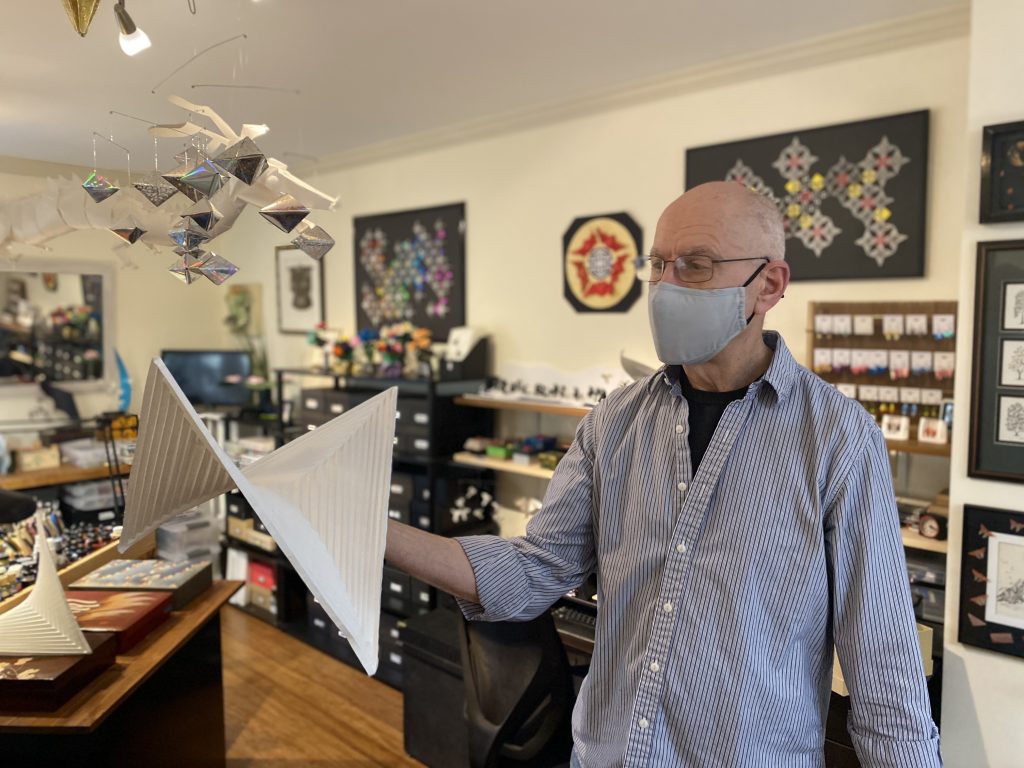
CB: Do you mind telling us a little bit about your Navy background?
RG: Ok, well you can’t really separate the two because very obviously origami was what I enjoyed doing.. And there I was in college, I kept changing my major all the time, but what I really enjoyed was going to the library and I started getting into Japanese art, Japanese culture, then I started taking Japanese language. When I got out of college I got a youth hostel pass and a rail pass and wandered around Japan. Saw really nice paper there!
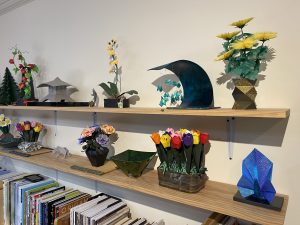 You’ve gotta remember handmade paper and high end paper was not common back in the 70s. That was when that whole hand paper making movement kind of got started in this country was in the 70s. I thought wow this is really cool.
You’ve gotta remember handmade paper and high end paper was not common back in the 70s. That was when that whole hand paper making movement kind of got started in this country was in the 70s. I thought wow this is really cool.
Then I got back and thought wow, I need to get a job.
I’m from New England, it’s sort of a Navy tradition up there, y’know you just had JFK had been president and everything and so I thought y’know join the Navy see the world maybe I’ll go back to Japan and that’s exactly what happened.
And I discovered I really liked being in the Navy. I loved working with the other sailors. I just felt it was a worthwhile thing and so even though I didn’t expect to when I started I wound up making a career out of it. But origami is the type of hobby, it doesn’t take a lot of equipment, so if you move all the time it doesn’t interfere with your hobby. And if I’m on a ship and all I have is a little one foot square, two foot square space where I can do my hobby, that’s enough. The Navy let me travel to a lot of other places.
CB: Did you see any performance art when you were in Japan ?
RG: Oh yeah, the highlight was when we were in Nara and they were doing a night time Noh performance with all the masks. It was sold out weeks ago but there was a little place you could look over the barrier. By torch light. It was just magical, it really was. I really enjoyed Japan. We were there for about 5 years.
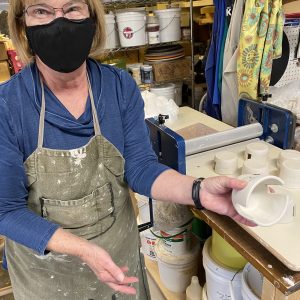 That’s where my wife started doing pottery. One of the Japanese women that worked in the office invited her out and that’s how she got started. Everywhere we moved after that Pam found some studio to work in and now she finally has her own.
That’s where my wife started doing pottery. One of the Japanese women that worked in the office invited her out and that’s how she got started. Everywhere we moved after that Pam found some studio to work in and now she finally has her own.
CB: Living the dream! Who are your favorite paper artists?
RG: Akira Yoshi is always sort of the Grandmaster, he’s the one that established modern origami. There are a couple different styles in origami. One is more naturalistic and another one is more mathematically driven. I kinda bounce between the two – my two favorites are Robert Lang and Michael LaFosse.
Funny anecdote: Michael LaFosse and I grew up in the same town and we were the same age, kids in the same town but we never bumped into each other. Michael got into Origami early. By the time he was a teenager he’s going down to NY. He’s a world class origamist. I’m a hobbyist who really enjoys playing with paper. If you ever get a chance watch it’s a PBS show “Between the Folds.” Michael is one of the people they interviewed. It won a Peabody. He’s not only a leading origamist he’s also an excellent paper maker. An example (he pulls out some beautiful gold flecked paper) This is some paper Michael made. See it’s got Mica embedded in it. See how it kind of shimmers?
You have to match the paper to what you’re trying to make.
Another favorite origami artist is Kunihiko Kasahara. He’s very approachable. And I love Helen Hiebert Studio. When I teach a lot of times what I’m teaching are classical designs or they’re inspired by somebody that works in the tradition.
Origami is often compared to music in that you’ve got composers, arrangers, conductors, performers. . .
I’m never gonna be a composer. If I had started young I was young coming with things but I’m more of an arranger, so when you get your piano you’ve got Beethoven for a beginner, Beethoven for an intermediate or one that takes something that might be more difficult and tries to rearrange it so somebody without much experience can enjoy making it. But I don’t want to do just simple stuff because that’s boring. You’re an adult. You want to make something interesting so that’s what I do. I do a lot of that. As a performer I’m ok – I’m like a high intermediate.
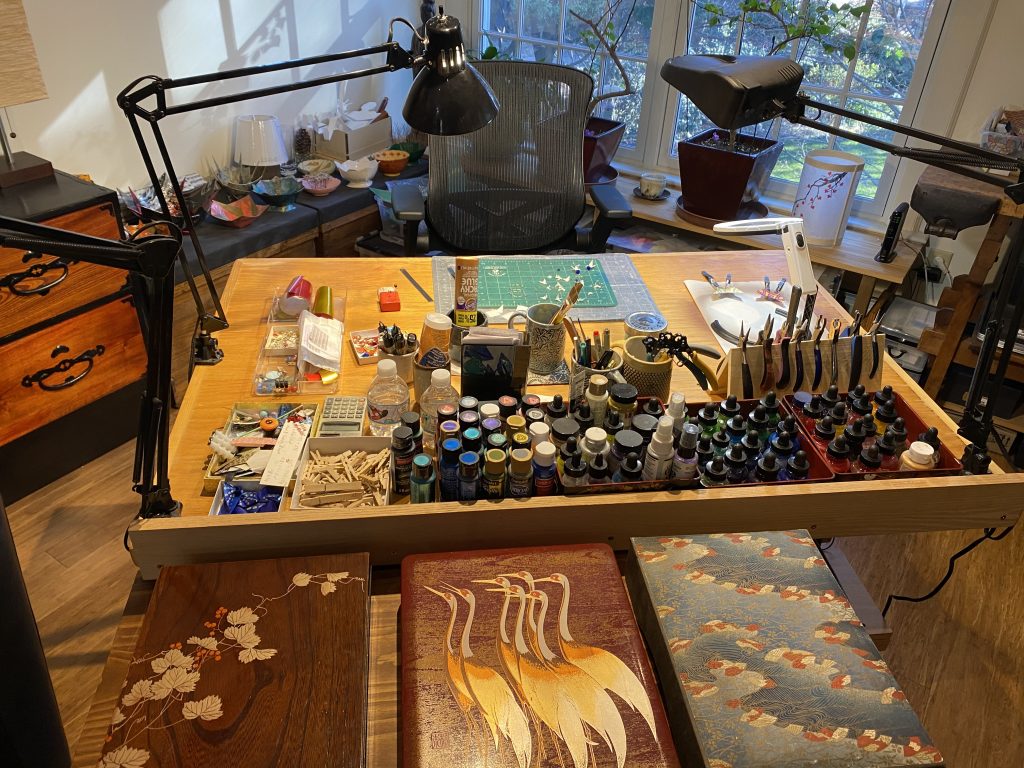
CB: Do you think someone who isn’t that great at math could succeed in your classes? (Asking for a friend.)
RG: Math has got nothing to do with it. It’s sort of like chess. Chess trains your mind, you don’t think about it. You’re just making moves. I had a student take my classes for a couple years and it helped her in her school work. She was more focused. Thinking ahead. Like in chess, think a step or two ahead so you know where you’re going with it. Visualization. If you’re folding a bird, where is the wing? Where is the tail?
Don’t overthink this. If you look at Origami Revolution – almost everything in nature is folded – even the way leaves unfold. It’s a very efficient way to compress things in size. The mathematician that invented the JPEG compression format also had origami as a hobby. So it’s a lot of yes, the whole mental thing but, you don’t have to know anything about math, but it’s like any art you have to have some visualization.
Say I’m designing anti aircraft missiles. I’ve got to train that thing how to track a target, get there, and make impact with it. A little leaguer does the same thing chasing a fly ball. He or she does not think about — ok here’s the trajectory or he’s the speed – no you just eyeball it and you catch it. Origami’s the same way. If you really want to you can actually very precisely do it or you can just do it.
And everybody thinks you have to be that rocket designer. No. You just have to be that little leaguer. I mean yeah are you gonna hit a couple off the nose first? Yeah of course you are! But it’s paper. It’s not like you’re in a wood turning class and you just ruined a piece of y’know fine maple. It’s a 6 cent piece of paper. You don’t want to be wasteful, but if all else fails it goes in the recycle bin. So you can’t take all this stuff too seriously.
CB: What’s your favorite thing about teaching?
RG: The Aha moment when somebody gets it.
CB: Favorite artists outside of paper?
RG: We collect Japanese woodblock prints. Contemporary ones, not so much the historical ones and because my wife’s a potter we have a variety of ceramic artists we like. But mostly paper art. These other things framed are done by other paper artists. It’s still not a very big field. Maggie Kerrigan in Virginia Beach turns books into really interesting things. There are all kinds of things you can do with paper! You can’t recycle these old books so you’ve got to do something with the paper. (He pulls out a book of poetry shaped into a heart sculpture with the flair of a magician.)
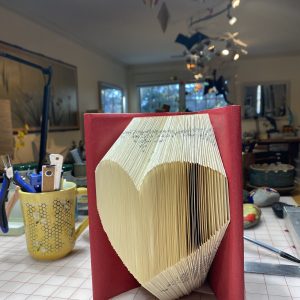 RG: It’s folded.
RG: It’s folded.
CB: Wow. That’s beautiful.
CB: Advice to artists of any age?
RG: Do what you enjoy, do what feels right for you and don’t spend too much time worrying about what other people think. When you’re just starting out you look at everybody else and go I could never be that good! When you compare yourself to other artists you start to worry am I good enough? I’m very fortunate that I’m about the only guy around here doing this. Unless you’re trying to make a living make what you enjoy. If you enjoy it – I really do believe your personality and mood comes through in what you make. Sometimes when you’re just goofing the stuff has a real sense of humor to it. I like that sometimes in an artist. I think I bet they had a good time making this. And there’s always the age old question “What’s the difference between art and craft?” and origami can go either way like ceramics can. It’s like, OK oil painting, you’re at the top of the pyramid and it all just kind of trickles down from there.
RG: I sometimes think of myself as more of an artisan. You have to have vision but you have to have craftsmanship too. A lot of art now is about the concept and it’s not that you can’t use inexpensive materials, but I think it should be put together. . . I think of some of the furniture that you buy in Japan and you take the back that you never see. . . the craftsman put the same care in the joints of the back knowing that nobody else would ever see it, but because he made it he wasn’t gonna make anything y’know that wasn’t good. And I see that in some others and I know I’m rambling here, but I got Pam a necklace – this is when we were out in California. I had no idea who made it but the work on the back of it that you’re not even gonna see was just as nice as the front. And you couldn’t reverse it, it wasn’t meant to be reversible. So y’know I called and said I bought something here and they said oh that’s so and so’s work. They knew immediately because of the quality of the craftsmanship. And unfortunately that woman died a year or two later of cancer which was unfortunate because she was so young and her work was so good. But I think she probably inspired a lot of students. So that’s kind of my view that yes you have to make something but you should still do as much as you can – take that care in how you construct it.
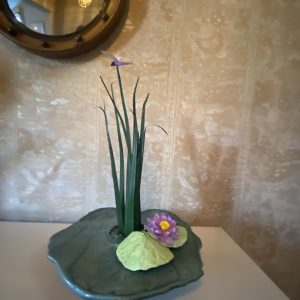 CB: Food for thought. Favorite plant?
CB: Food for thought. Favorite plant?
RG: You know it’s hard to say. We obviously have a lot of camellias in the yard and that came with the house. I probably tend more to shrubs just as a rule as opposed to smaller things. One of my favorites is we have a Chinese Paper Bush. The Edgeworthia is just starting to bloom. It smells so nice when you walk out to the studio.
CB: Do you have a favorite memory at the garden?
RG: There are times when the light is just beautiful. I tend to like the Japanese garden, no surprise there. The bonsai added a really nice touch. And that far section past the buttery garden, the sort of woodsy really quiet place with May apples. . . if there aren’t planes going overhead you could be out in the woods somewhere.
And the exhibits have been wonderful. Lantern Asia. Those huge sculptures while you’re there at night. We like to go late in the afternoon so you can walk around in daylight and it gets progressively darker and we love the holiday lights when you can walk. It’s just one of those things we tell people – If you come to Norfolk you need to do the garden.
You can find Rich on Facebook @Rich Gray Paper Arts
For more information on future origami classes at NBG check our website at https://norfolkbotanicalgarden.org/learn/adult-education/adult-classes/ or @NBGAdultEducation on Facebook.





